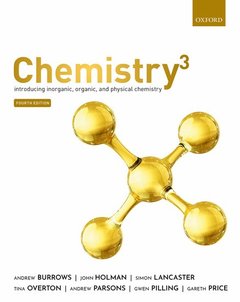Chemistry³ (4th Ed.) Introducing inorganic, organic and physical chemistry
Langue : Anglais
Auteurs : Burrows Andrew, Holman John, Lancaster Simon, Overton Tina, Parsons Andrew, Pilling Gwen, Price Gareth

Chemistry is widely considered to be the central science: it encompasses concepts on which all other branches of science are developed. Yet, for many students entering university, gaining a firm grounding in chemistry is a real challenge. Chemistry³ responds to this challenge, providing students with a full understanding of the fundamental principles of chemistry on which to build later studies. Uniquely amongst the introductory chemistry texts currently available, Chemistry³'s author team brings together experts in each of organic, inorganic, and physical chemistry with specialists in chemistry education to provide balanced coverage of the fundamentals of chemistry in a way that students both enjoy and understand. The result is a text that builds on what students know already from school and tackles their misunderstandings and misconceptions, thereby providing a seamless transition from school to undergraduate study. Written with unrivalled clarity, students are encouraged to engage with the text and appreciate the central role that chemistry plays in our lives through the unique use of real-world context and photographs. Chemistry³ tackles head-on two issues pervading chemistry education: students' mathematical skills, and their ability to see the subject as a single, unified discipline. Instead of avoiding the maths, Chemistry³ provides structured support, in the form of careful explanations, reminders of key mathematical concepts, step-by-step calculations in worked examples, and a Maths Toolkit, to help students get to grips with the essential mathematical element of chemistry. Frequent cross-references highlight the connections between each strand of chemistry and explain the relationship between the topics, so students can develop an understanding of the subject as a whole. Digital formats and resources Chemistry³ is available for students and institutions to purchase in a variety of formats, and is supported by online resources. The e-book offers a mobile experience and convenient access along with functionality tools, navigation features, and links that offer extra learning support: www.oxfordtextbooks.co.uk/ebooks The e-book also features interactive animations of molecular structures, screencasts in which authors talk step-by-step through selected examples and key reaction mechanisms, and self-assessment activities for each chapter. The accompanying online resources will also include, for students: · Chapter 1 as an open-access PDF; · Chapter summaries and key equations to download, to support revision; · Worked solutions to the questions in the book. The following online resources are also provided for lecturers: · Test bank of ready-made assessments for each chapter with which to test your students · Problem-solving workshop activities for each chapter for you to use in class · Case-studies showing how instructors are successfully using Chemistry3 in digital learning environments and to support innovative teaching practices · Figures and tables from the book
Andrew Burrows is Professor of Inorganic Chemistry at the University of Bath. He completed his first degree and doctorate at the University of Oxford and worked in Strasbourg and Imperial College London before moving to Bath, where he is currently Head of Department. He has taught many aspects of inorganic chemistry, though his current courses focus on s- and d-block chemistry. His research interests are in porous materials such as metal-organic frameworks and he has published over 160 papers. John Holman is Emeritus Professor in the Chemistry Department at the University of York, Past-President of the Royal Society of Chemistry (2016-2018), and Senior Adviser in Education at the Gatsby Foundation. He was the Founding Director of the National Science Learning Centre from 2004 until September 2010, and adviser to the English government as National Science, Technology, Engineering and Mathematics (STEM) Director from 2006 until September 2010. He has taught learners of chemistry at both school and undergraduate level, has created curricula and written books for science learners up to and including undergraduates, and was the founding director of the Salters Advanced Chemistry programme. In 2014 he was named by the Science Council as one of the 100 leading practising and inspirational UK scientists and in the same year won the Royal Society of Chemistry's Lord Lewis Award and the Royal Society's Kavli Education Award. In 2010 he was knighted by the Queen for services to education. Simon Lancaster has taught Chemistry at the University of East Anglia since his appointment as a lecturer in 2000. He won a National Teaching Fellowship and an RSC Higher Education Teaching Award in 2013 for 'blurring the boundaries between the internet and the lecture theatre'. Simon was promoted to a chair in Chemistry Education in 2014. He was selected as one of RSC's 175 face of diversity in 2016 and championed inclusion and diversity as President of the Education Division Council from 2
Date de parution : 09-2021
Ouvrage de 1440 p.
22x27.6 cm
© 2024 LAVOISIER S.A.S.



